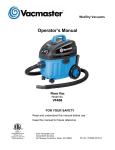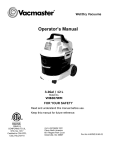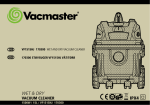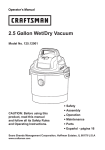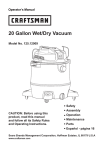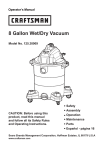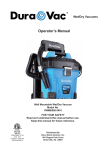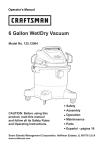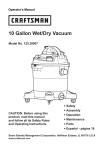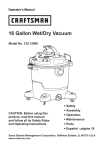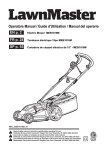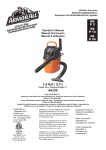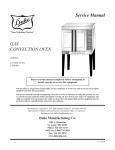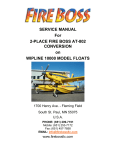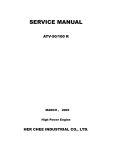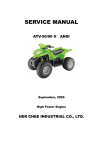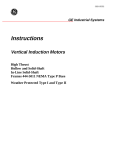Download Craftsman 4-Gallon Owner's Manual
Transcript
Operator’s Manual 4 Gallon Wet/Dry Vacuum Model No. 125.12002 CAUTION: Before using this product, read this manual and follow all its Safety Rules and Operating Instructions. Safety Assembly Operation Maintenance Parts Español - página 16 Sears Brands Management Corporation, Hoffman Estates, IL 60179 U.S.A www.craftsman.com Warranty CRAFTSMAN ONE YEAR FULL WARRANTY FOR ONE YEAR from the date of purchase, this product is warranted against defects in material or workmanship. A defective product will be replaced free of charge. For warranty coverage details to obtain free replacement, visit the web page: www. craftsman.com/warranty This warranty does not cover bags, filters, hose or attachments, which are expendable parts that can wear out from normal use within the warranty period. This ONE YEAR warranty is void if this product is ever used while providing commercial services or if rented to another person. For 90 DAY commercial and rental use terms, see the Craftsman warranty web page. This warranty gives you specific legal rights, and you may also have other rights which vary from state to state. Sears Brands Management Corporation, Hoffman Estates, IL 60179 IMPORTANT SAFETY INSTRUCTIONS READ AND UNDERSTAND ALL INSTRUCTIONS BEFORE USING THIS VACUUM motor can ignite flammable vapors or dust. • Do not vacuum anything that is burning or smoking, such as cigarettes, matches, or hot ashes. • Keep cord away from heated surfaces. • Do not expose to rain. Store indoors. • Do not unplug by pulling on cord. To unplug, grasp the plug, not the cord. • Do not use with damaged cord, plug or other parts. • If vac is not working as it should, has been dropped, damaged, left outdoors, or dropped into water, take it to a service dealer for inspection and repair before using it again. • Do not pull or carry by cord, use cord as handle, close a door on cord, or pull cord around sharp edges or corners. • Do not run Wet/Dry Vac over cord. • Do not handle plug or the Wet/Dry Vac with wet hands. • To reduce the risk of health hazards from vapors or dusts, do not vacuum toxic materials. • Do not store near hazardous materials. • Do not use this Wet/Dry Vac with a torn filter or without the filter installed except when vacuuming liquids as described in the operation section of this manual. • Do not allow to be used as a toy. Close attention is necessary when used by or near children. • To reduce the risk of injury from accidental Read and understand this operator's manual and all labels on the Wet/Dry Vacuum cleaner before operating. Safety is a combination of common sense, staying alert and knowing how your vacuum works. Use this Wet/Dry Vac only as described in this manual. To reduce the risk of personal injury or damage to your Wet/Dry Vac, use only Craftsman recommended accessories. Household Type SAVE THIS MANUAL FOR FUTURE REFERENCE. When using an electrical appliance, basic precautions should always be followed including the following: WARNING: TO REDUCE THE RISK OF FIRE, ELECTRIC SHOCK OR INJURY: • Do not run vac unattended. • Do not vacuum, or use this Wet/Dry Vac near flammable liquids, gases, or explosive vapors like gasoline or other fuels, lighter fluids, cleaners, oil-based paints, natural gas, hydrogen, or explosive dusts like coal dust, magnesium dust, grain dust, or gun power. Sparks inside the 2 starting, unplug power cord before changing or cleaning filter. • Do not leave Wet/Dry Vac unattended when plugged in. Unplug from outlet when not in use and before servicing. • Turn off Wet/Dry Vac before unplugging. • Do not put any object into ventilation openings. Do not vacuum with any ventilation openings blocked; keep free of dust, lint, hair or anything that may reduce air flow. • Keep hair, loose clothing, fingers, and all parts of body away from openings and moving parts. • To reduce the risk of falls, use extra care when cleaning on stairs. Observe the following warnings that appear on the motor housing of your Vac: DOUBLE INSULATED GROUNDING NOT REQUIRED. WHEN SERVICING USE ONLY IDENTICAL REPLACEMENT PARTS. Polarized Plug To reduce the risk of electrical shock, this appliance has a polarized plug (one with the blade wider than the other). This plug will fit in a polarized outlet only one way. If the plug does not fit fully in the outlet, reverse the plug. If it still does not fit, contact a qualified electrician to install the proper outlet. Do not change the plug in any way. Double insulation eliminates the need for the three wire grounded power cord and grounded power supply system. Extension Cords When using an extension cord with your Wet/Dry Vac refer to the following table to determine the required A.W.G. (American Wire Gauge) wire size. Before using Wet/Dry Vac, make sure it is in good working condition, including power cord. Also, make sure extension cord is in good working condition prior to use. Make repairs or replacements before using the vacuum cleaner. Only use extension cords that are rated for outdoor use. 110V-120V Amps 0-6 7-10 11-12 13-16 25 Feet 7.5 Meters 18 18 16 14 Length of Extension Cord 50 Feet 100 Feet 15.25 Meters 30.5 Meters A.W.G Wire Size 16 16 16 12 16 14 14 150 Feet 45.7 Meters 14 12 12 Not recommended 3 Introduction This Wet/Dry Vac is intended for household use. It may be used for vacuuming of use. It may be used for vacuuming of blower. Read this operator's manual to familiarize yourself with the product features and to understand the specific usage of your new Wet/Dry Vac. Table of Contents Section Page Section Page Warranty ................................................. 2 Maintenance.........................................10 Important Safety Instructions ........... 2 Emptying the Collection Tank ........ 10 Polarized Plug.................................... 3 Installing & Cleaning The Cartridge Filter ......................... 10 Extension Cords ..................................... 3 Installing & Cleaning Foam Sleeve Filter .......................... 11 Introduction ............................................ 4 Table of Contents ................................... 4 Installing and Cleaning HEPA Filter....................................... 11 Assembly ................................................ 5 Carton Contents List ......................... 5 Cleaning & Disinfecting the Wet/Dry Vac .............................. 12 Unpacking Your Wet/Dry Vacuum & General Assembly .......................... 6 Storage ............................................ 12 Operation ................................................ 8 Troubleshooting ................................... 13 Vacuuming Dry Materials .................. 8 Repair Parts.......................................... 14 Vacuuming Liquids ............................ 9 4 Assembly Remove entire contents of carton and check for parts inside the collection tank. Check each item against the Carton Contents List. If any parts are missing or damaged please call 1-800-469-4663 for replacement. A Carton Content List Key A B C D E F G H I J K L M N O P Q R S T Description ........................Qty. Vac Assembly ......................1 Hose.....................................1 2-in-1 Utility Nozzle .............1 Round Dust Brush ...............1 Crevice Tool .........................1 Floor Combo Nozzle ...........1 Cartridge Filter ....................1 Filter Retainer ......................1 Dust Bag ..............................1 Foam Sleeve Filter ..............1 Tool Caddy ..........................1 Extension Wand ..................3 HEPA Filter Door .................1 HEPA Filter ..........................1 Casters ................................2 Rear Wheels ........................2 Handle .................................1 Hose Storage Rack .............2 Bag with 4 Screws ..............1 Operator’s Manual...............1 B G C I H M N D J O E F K P Q L R Handle Cord Rewind Button Power Switch Power Head Hose Storage Rack Tool Caddy Latch Vacuum Port Rear Wheel Container Casters 5 S T Assembly (continued) Before beginning assembly of product, make sure all parts are present. Compare parts with package contents list and diagram. If any part is missing or damaged, do not attempt to assemble the product. Contact customer service for replacement parts. A Philips head screw driver is required. 1 2 3 4 6 5 1 1 7 8 10 9 2 2 13 12 11 1 2 14 15 16 17 ! WARNING: Do not plug in power cord to power outlet, make sure plug is disconnected before assembling the wet/dry vac. 6. Slide the rear wheels into the slots making sure to match the wheel number to the corresponding number on the wheel slot and use screws to secure them. Do not over tighten the screw. (Fig. 6 & 7) 7. Your vacuum comes ready for dry vacuum cleaning. If cartridge filter is not installed refer to page 10 for filter installation. (Fig. 8 & 9) 8. For wet vacuum cleaning, install the supplied foam filter. (Fig. 10) See page 11 for filter installation. 9. Place the power head back on the collection tank, aligning the top section with the latches, and lock into place. (Fig. 11) UNPACKING YOUR WET/DRY VACUUM & GENERAL ASSEMBLY 1. Verify that the power cord is disconnected from the outlet. (Fig. 1) 2. Undo the latches. (Fig. 2) 3. Lift the power head off the collection tank. (Fig. 3) 4. Remove the contents from inside the collection tank, make sure you have all contents as listed on page 5. (Fig. 4) 5. Turn the collection tank upside down and insert the two casters into the slots on the front side of the collection tank. Apply downward pressure until the casters snap into place. (Fig. 5) 6 10. Insert the handle into the slots located on the top of the power head and secure it with the screws provided. Do not over tighten the screw. (Fig. 12) 11. Position the hose storage rack as illustrated. insert one side of the rack into the channel making sure it is secured in place. Squeeze in the other end and insert it into the corresponding channel making sure it is secured. (Fig. 13 & Fig. 14) 12. Hang the tool caddy to the hooks on the rear of the vacuum. (Fig. 15) 13. Secure the large end of the hose onto the vacuum port on the collection tank and screw into place. (Fig. 16) 14. Choose the desired accessories and extension wands and push onto the hose. (Fig. 17) 7 Operation Vacuuming Dry Materials ! WARNING: Be sure to read, understand and apply all the information in the Important Safety Instructions section at the beginning of this operator's manual. Do not vacuum in areas with flammable gases, vapors, or explosive dusts in the air. Flammable gases or vapors include but are not limited to: lighter fluid, solvent type cleaners, oil-base paints, gasoline, alcohol or aerosol sprays. Explosive dusts include but are not limited to: coal, magnesium, grain or gun powder. To reduce the risk of health hazards from vapors or dust, do not vacuum toxic materials. 1 2 6 5 4 3 1 7 8 9 10 1. Verify that the power cord is disconnected from the outlet. (Fig. 1) 2. In order to prepare your vacuum for dry vacuuming, verify that the cartridge filter is securely mounted. Make sure the filter is pushed in until it stops against the power head. (Fig. 2) (Your Wet/Dry Vac comes with the cartridge filter preinstalled, if not, see page 10 for installation instructions.) 3. Place filter retainer on top of cartridge filter and tighten by turning the retainer handle clockwise. (Fig. 3) 4. Optional, for improved dust filtering, fit collection dust bag flange onto the inlet stub, taking care not to damage the bag. (Fig. 4) 5. Place the power head back on the collection tank, aligning the top section with the latches, and lock into place. (Fig. 5) 6. Insert the locking end of the hose into the vacuum port and screw in place. Push the desired extension wands or 2 11 attachments onto the free end of the hose. (Fig. 6) 7. Verify that the switch is in the ‘O’ OFF position before plugging the power cord into the outlet. (Fig. 7 & 8) 8. Turn the motor on by pressing the switch to the ‘I’ ON position. (Fig. 9) 9. Once you have completed vacuuming, press the switch to the ‘O’ OFF position and unplug the power cord from the outlet. (Fig. 10 & 11) O = OFF I = ON DO NOT USE THE CARTRIDGE FILTER AND THE DUST COLLECTION BAG FOR LIQUID VACUUMING. CAUTION: Do not vacuum drywall dust, fireplace soot or ash with standard Wet/ Dry filter. This is very fine dust which will not be captured by the filter and may cause damage to motor. When vacuuming fine dust use a fine dust filter (sold separately). 8 Operation (continued) Vacuuming Liquids ! WARNING: Be sure to read, understand and apply all the information in the Important Safety Instructions section at the beginning of this operator's manual. Do not vacuum in areas with flammable gases, vapors, or explosive dusts in the air. Flammable gases or vapors include but are not limited to: lighter fluid, solvent type cleaners, oil-base paints, gasoline, alcohol or aerosol sprays. Explosive dusts include but are not limited to: coal, magnesium, grain or gun powder. To reduce the risk of health hazards from vapors or dust, do not vacuum toxic materials. ! WARNING: Do not plug in power cord to power outlet, make sure plug is disconnected before assembling the Wet/Dry Vac. 1 2 3 7 8 9 4 1. Verify that the power cord is disconnected from the outlet. Verify that the collection tank is clean and free of dust and dirt. (Fig. 1) 2. Remove cartridge filter and the dust collection bag, then carefully install the foam sleeve filter over the filter cage and place the power head back on the collection tank. (Fig. 2) See filter installing instructions on page 11. 3. Fit the desired extension wands or nozzle to the vacuum hose. (Fig. 3) 4. Verify that the switch is in the ‘O’ OFF position before plugging the power cord into the outlet. (Fig. 4 & 5) 5. Turn the motor on by pressing the switch to the ‘I’ ON position. (Fig. 6) 6. After use, flip the switch to the ‘O’ OFF position and unplug the power cord from the outlet. (Fig. 7 & 8) 7. Empty the collection tank into a suitable receptacle or drain. (Fig. 9) 5 6 IMPORTANT! When vacuuming large quantities of liquids, do not immerse the nozzle completely in the liquid; leave a gap at the tip of the nozzle opening to allow air inflow. The machine is fitted with a float valve that stops the suction action when the collection tank reaches its maximum capacity. You will notice an increase in motor speed. When this happens, turn off the machine, disconnect from power supply, and drain the liquid into a suitable receptacle or drain. After wet vacuuming, turn the machine off and remove plug from power supply. Empty the collection tank, clean and dry the inside and outside before storage. REMEMBER! The foam filter must be removed after wet vacuuming and a reusable cloth filter must be installed before dry vacuuming again. 9 Maintenance Emptying the Collection Tank 1 2 3 4 5 ALWAYS USE DUST FILTER FOR DRY VACUUMING. If the machine is used without the cartridge filter, the motor will burn out and the warranty will be voided. Always keep spare filters on-hand. NOTICE! The filters included are made of high quality material designed to stop small dust particles. The cartridge filter should be used for dry pick-up only. A dry cartridge filter is necessary to pick up dust. If the cartridge filter is wet, it will clog quickly and be very difficult to clean. Handle the filter carefully when removing it for cleaning and replacing it. Check the filters for tears or small holes, a small hole can let dust pass through and out of the cleaner. Do not use a filter with holes or tears in it, replace it immediately. 1. Verify that the power cord is disconnected from the outlet. (Fig. 1) 2. Disconnect the hose from the vacuum. (Fig. 2) 3. Undo the latches and remove the power head from the collection tank. (Fig. 3) 4. Clear all dirt or debris from the collection tank and hose. (Fig. 4) 5. Clean the foam filter by washing it with water and mild soap. (Fig. 5) 6. Check the hose, attachments, and power cord to verify that they have not been damaged. IMPORTANT! Clean or change the cartridge filter regularly for best performance. ! WARNING: Always disconnect the plug from the power outlet before removing the power head from collection tank. Installing & Cleaning The Cartridge Filter 1 2 3 4 Installing Cartridge Filter 1. Verify that the power cord is disconnected from the outlet. (Fig. 1) 2. Remove power head and place in upside down position. 3. Install the cartridge filter over the filter cage and carefully push filter in until it stops against the power head. (Fig. 2 & 3) 4. Place filter retainer on top of cartridge filter and tighten down by turning retainer clockwise. (Fig. 4 & 5) 5 6 Removing and Cleaning Cartridge Filter 1. Unlock and remove the filter retainer by turning retainer handle counter clockwise. 2. Carefully hold and pull the cartridge filter up for removal. (Fig. 6) 3. Clean the cartridge filter by gently tapping or brushing dirt off. Cleaning should not be done indoors in living areas. For optimal performance a new filter is recommended. 10 Maintenance (continued) Installing & Cleaning Foam Sleeve Filter 1 2 5 4 3 Installing Foam Sleeve Filter 1. Verify that the power cord is disconnected from the outlet. (Fig.1) 2. Remove power head and place in upside down position. Follow instructions to remove cartridge filter. 3. Carefully slide foam sleeve filter down over the filter cage making sure the whole cage is covered. (Fig. 2 & 3) 4. Replace the power head on to the collection tank. Cleaning Foam Sleeve Filter 1. With the removed power head in the upside down position, carefully remove foam sleeve filter. (Fig. 4) 2. Use a mild soap and water solution to wash foam sleeve filter and rinse with clean water. (Fig. 5) 3. Allow filter to air dry before installing and using again. Installing and Cleaning HEPA Filter 1 2 7 8 3 4 1. Verify that the power cord is disconnected from the outlet. (Fig.1) 2. Unlock the filter door by lifting the lock tab UP to the unlocked position and pull the door out. (Fig. 2 & 3) 3. Remove the HEPA filter cartridge from the vacuum. (Fig.4) 5 6 4. Clean filter by brushing dirt off. For optimal performance a new filter is recommended. (Fig.5) 5. Install the cleaned or new filter into place. (Fig. 6) 6. Insert the filter door tabs into the upper slots and lock the filter door into place. (Fig. 7 & 8) 11 Maintenance (continued) Cleaning and Disinfecting the Wet/Dry Vac To keep your Wet/Dry Vac looking its best, clean the outside with a cloth dampened with warm water and mild soap. To clean the collection tank: 1. Dump debris out. 2. Wash collection tank thoroughly with warm water and mild soap. 3. Wipe out with dry cloth. To disinfect the collection tank: 1. Pour 1 gallon of water and 1 teaspoon chlorine bleach into the collection tank. 2. Let solution stand for 20 minutes, carefully swishing every few minutes, making sure to wet all inside surfaces of the collection tank. 3. Empty drum after 20 minutes. Rinse with water until bleach smell is gone. Allow drum to dry completely before sealing the motor on the collection tank. Before prolonged storage or as needed (i.e. after waste water pick up) the collection tank should be disinfected. Storage 1 Before storing your vac, the collection tank should be emptied and cleaned. The hose should be wrapped with the storage racks. The cord and accessories should be stored as illustrated on the right (Fig. 1-3) so they can be readily available when needed. Store vac indoors. 3 12 2 Troubleshooting WARNING: TO REDUCE THE RISK OF ELECTRIC SHOCK UNPLUG BEFORE TROUBLESHOOTING. Problem Possible Causes Corrective Action Vacuum will not operate . 1) No power supply. 1) Check power supply – cord, breakers, fuses. 2) Faulty power cord. 2) Unplug and check the power cord. If damaged, have it repaired by a professional. 3) Collection tank is full. 4) Switch in the wrong position. 3) Empty collection tank. 4) Press the ON ‘I’ button on the power head. 1) Attach or replace the Dust comes out from motor cover. 1) The cartridge filter is missing or damaged. Reduced efficiency and motor/speed vibration. 1) There is a blockage in the nozzle, hose, or the tank inlet. The dust filter is clogged by fine dust. 13 cartridge filter. 1) Check nozzle, hose and tank inlets for blockage. Take off the filter and clean it. Or install new filter. Repair Parts 125.12002 4 Gallon Wet/Dry Vac Always order by part number, not by key number. Always mention the model number when ordering parts. The model number is found on the serial plate located on the vacuum. To order parts, call 1-800-469-4663. WARNING: Servicing of double-insulated wet/dry vacuum. With double-insulated wet/dry vacuum, two systems of insulation are provided instead of grounding. No grounding means is provided on a double-insulated appliance, nor should a means for grounding be added. Servicing a double insulated wet/dry vacuum requires extreme care and knowledge of the system, and should be done only by qualified service personnel. Replacement parts for a double-insulated wet/dry vacuum must be identical to the parts they replace. Your double-insulated wet/dry vacuum is marked with the words ‘double insulated’ and the symbol (square within a square) may also be marked on the appliance. Key Number 1 2 3 4 5 6 7 8 9 10 11 12 13 14 15 16 17 18 19 20 21 22 23 24 25 Drawing Description GD41BX.X0.16 VH60P1.11.00 VE01PW.10.30.W5.00 VH60P1.10.00.X0 VH60P1.X0.04 TVQTZS.04.YZ VI02SR.10.06 VH60P1.20.01.F3.SY TVQTDK.11.00 TVQTXK.08.01 TVQTGL.17.00.F3 TVQTJL.04.00 TVQTGL.18.00.F3 17866 FV7774.01.00 17863 17888 17810 FV9543.03.20 FV9641.03.00.01 17849 17862 FV7723.01.00 FV9241.04.01 VH60BZ.20.D6.01 Handle HEPA Filter Door HEPA Exhaust Filter Power Head Hose Storage Rack Float Filter Cage Collection Tank Latch Aassembly Hose inlet Left Rear Wheel Caster Right Rear Wheel Hose 2-in-1 Utility Nozzle Crevice Tool Foam Sleeve Cartridge Filter Filter Retainer Dust bag Extension Wands Round Brush Floor Combo Nozzle Tool Caddy Operator’s Manual 14 Quantity 1 1 1 1 2 1 1 1 2 1 1 2 1 1 1 1 1 1 1 1 3 1 1 1 1 Repair Parts (Continued) 4 Gallon Wet/Dry Vac 15 Manual Del Operador Aspiradora Para Materiales Húmedos/Secos De 4 Galones Núm. de Modelo 125.12002 PRECAUCIÓN: Antes de usar este producto, lea este manual y siga todas las reglas de seguridad e instrucciones de operación. Seguridad Ensamble Operación Mantenimiento Partes English- Page 1 Sears Brands Management Corporation, Hoffman Estates, IL 60179 EE.UU. www.craftsman.com Garantía GARANTÍA TOTAL DE UN AÑO DE CRAFTSMAN DURANTE UN AÑO a partir de la fecha de compra, este producto está garantizado contra defectos de material o mano de obra. Un producto defectuoso será reemplazado sin ningún costo. Para detalles sobre la cobertura de la garantía para obtener un reemplazo gratuito, visite la página web: www.craftsman.com/warranty. Esta garantía no cubre bolsas de cubierta, filtros, mangueras o accesorios, que son partes consumibles que pueden desgastarse por el uso normal dentro del periodo de la garantía. Esta garantía de UN AÑO es inválida si este producto alguna vez se usa para servicios comerciales o si se renta a otra persona. Para obtener los términos de uso comercial y de renta por 90 DÍAS, consulte la página web de la garantía de Craftsman. Esta garantía le ofrece derechos legales específicos y también puede tener otros derechos que varían de estado a estado. Sears Brands Management Corporation, Hoffman Estates, IL 60179 INSTRUCCIONES DE SEGURIDAD IMPORTANTES LEA Y COMPRENDA TODAS LAS INSTRUCCIONES ANTES DE USAR ESTA ASPIRADORA. Lea y entienda este manual del operador y todas las etiquetas de la aspiradora de material húmedo/seco antes de operarla. La seguridad es una combinación de sentido común, mantenerse alerta y saber cómo funciona su aspiradora. Use esta aspiradora de material húmedo/seco únicamente como se describe en este manual. Para reducir el riesgo de lesiones personales o daños a la aspiradora de material húmedo/seco, use únicamente los accesorios recomendados de Craftsman. Tipo doméstico GUARDE ESTE MANUAL PARA CONSULTA FUTURA. Al utilizar un electrodoméstico, siempre se deben seguir las precauciones básicas, incluyendo las siguientes: ADVERTENCIA: PARA REDUCIR EL RIESGO DE INCENDIOS, DESCARGA ELÉCTRICA O LESIONES: • No deje la aspiradora desatendida. • No aspire ni use esta aspiradora de material húmedo/seco cerca de líquidos inflamables, gases o vapores explosivos como gasolina u otros combustibles, líquidos encendedores, limpiadores, pinturas con base de aceite, gas natural, hidrógeno o polvos explosivos como polvo de carbón, polvo de magnesio, polvo de granos o pólvora. Las chispas dentro del motor pueden encender vapores o polvos inflamables. • No aspire nada que se esté quemando o emitiendo humo, como cigarrillos, cerillos o cenizas calientes. • Mantenga el cable alejado de superficies calientes. • No la exponga a la lluvia. Almacénela en interiores. • No desconecte jalando el cable de corriente. Para desconectar, sujete el enchufe y no el cable. • No la use con el cable, enchufe u otras partes dañadas. • Si la aspiradora no está funcionando como debería, se ha dejado caer, está dañada, se dejó a la intemperie o cayó en agua, llévela a un distribuidor de servicio para que la inspeccione y repare antes de usarla de nuevo. • No la jale ni cargue por el cable, ni use el cable como agarradera, no cierre una puerta sobre el cable ni jale el cable por bordes filosos ni esquinas. • No pase la aspiradora de material húmedo/seco por encima del cable. • No maneje el enchufe ni la aspiradora de material húmedo/seco con manos húmedas. • Para reducir el riesgo de peligros a la salud debido a vapores o polvos, no aspire materiales tóxicos. • No almacene la aspiradora cerca de materiales peligrosos. • No use esta aspiradora de material húmedo/ seco con un filtro rasgado o sin el filtro instalado, excepto cuando se aspiren los líquidos que se describen en la sección de operación de este manual. • No permita que se use como un juguete. Se necesita poner mucha atención cuando se usa cerca de niños. • Para reducir el riesgo de una lesión por un encendido accidental, desconecte el cable incomplete corriente antes de cambiar o limpiar el filtro. 17 • No deje la aspiradora de material húmedo/seco desatendida cuando la conecte. Desconéctela del tomacorriente cuando no está en uso y antes de realizar el servicio. • Apague la aspiradora de material húmedo/seco antes de desconectarla. • No coloque ningún objeto en las aberturas de ventilación. No aspire con ninguna de las aberturas de ventilación bloqueadas; manténgala libre de polvo, pelusa, cabello o cualquier objeto que pudiera reducir el flujo de aire. • Mantenga el cabello, ropa holgada, dedos y todas las partes del cuerpo lejos de las aberturas y partes móviles. • Para reducir el riesgo de caídas, tenga mucho cuidado al limpiar escaleras. Enchufe polarizado Para reducir el riesgo de una descarga eléctrica, este electrodoméstico tiene un enchufe polarizado (uno con un contacto más ancho que el otro). Este enchufe entrará en un tomacorriente polarizado solo de una manera. Si el enchufe no entra por completo en el tomacorriente, invierta el enchufe. Si aún no entra, comuníquese con un electricista calificado para instalar el tomacorriente adecuado. No modifique el enchufe de ninguna manera. El doble aislamiento elimina la necesidad de una extensión de tres contactos con conexión a tierra y un sistema de suministro de energía con conexión a tierra. Obedezca las siguientes advertencias que aparecen en la caja del motor de su aspiradora: NO REQUIERE DE CONEXIÓN A TIERRA CON DOBLE AISLAMIENTO. AL REALIZAR EL SERVICIO, USE ÚNICAMENTE PARTES DE REPUESTO IDÉNTICAS. ADVERTENCIA: • Por su propia seguridad, lea y entienda el manual del propietario. • No permita que la unidad funcione si está desatendida. • No levante cenizas calientes, carbón, materiales tóxicos, inflamables u otros materiales peligrosos. • No la use alrededor de líquidos explosivos o vapores. ADVERTENCIA: Para reducir el riesgo de una descarga eléctrica, no la exponga a la lluvia y almacénela en interiores. Extensiones Al usar una extensión con la aspiradora de material húmedo/seco, consulte la siguiente tabla para determinar el tamaño de cable A.W.G. (calibre americano de cables) requerido. Antes de usar la aspiradora de material húmedo/seco, asegúrese de que esté en buenas condiciones, incluyendo el cable de corriente. Además, asegúrese de que la extensión esté en buenas condiciones antes de usarla. Realice las reparaciones o reemplazos necesarios antes de usar la aspiradora. Solo use extensiones que están clasificadas para uso en exteriores. Longitud de las extensiones 110V-120V 25 pies 7,5 metros Amperes 0-6 7-10 11-12 13-16 50 pies 15,25 metros 100 pies 30,5 metros 150 pies 45,7 metros Tamaño de cable de A.W.G 18 18 16 14 16 16 16 12 18 16 14 14 14 12 12 No se recomienda Introducción Esta aspiradora de material húmedo/seco está diseñada para aspirar materiales húmedos y secos, además puede usarse como un soplador. Lea este manual del operador para familiarizarse con las características del producto y para entender el uso específico de su nueva aspiradora de material húmedo/seco. Índice Sección Sección Página Página Garantía .................................................... 17 Mantenimiento ......................................... 25 lnstrucciones de seguridad importantes .......................................... 17 Cómo vaciar el tanque de recolección ......................................... 25 Enchufe polarizado.............................. 18 Instalación y limpieza del filtro de cartucho .............................................. 25 Extensiones .............................................. 18 Instalación y limpieza del filtro de manga de espuma ............................. 26 Introducción ............................................. 19 Índice ........................................................ 19 Instalación y limpieza del filtro HEPA ........................................... 26 Ensamble .................................................. 20 Limpieza y desinfección de la aspiradora de material húmedo/seco......................................27 Lista del contenido de la caja ............. 20 Desempaque de la aspiradora de material húmedo/seco y ensamble general.................................................. 21 Almacenamiento ................................27 Resolución de problemas........................28 Operación ................................................. 23 Partes de repuesto ..................................29 Aspiración de materiales secos ......... 23 Aspiración de líquidos......................... 24 19 Ensamble Retire todo el contenido de la caja y verifique si hay partes dentro del tanque de recolección. Verifique cada parte contra la lista de contenido de la caja. Si hay alguna parte faltante o dañada, llame al 1-800-469-4663 para recibir un reemplazo. Lista Del Contenido De La Caja Clave Descripción Cantidad A Ensamble de la aspiradora.......1 B Manguera ..................................1 C Boquilla de uso general 2 en 1 .........................................1 D Cepillo redondo para polvo ......1 E Herramienta para resquicios ..................................1 F Boquilla combinada para pisos .........................................1 G Filtro de cartucho......................1 H Retenedor del filtro ...................1 I Bolsa para polvo .......................1 J Filtro de manga de espuma......1 K Caja de herramientas................1 L Tubo extensor ...........................3 M Puerta del filtro HEPA ...............1 N Filtro HEPA ................................1 O Ruedas ......................................2 P Ruedas traseras ........................2 Q Agarradera ................................1 R Colgador para almacenamiento de manguera .............................2 S Bolsa con 4 tornillos .................1 T Manual del operador ................1 A B G C I H M D N J O P E F K Q L R S Agarradera Handle Botón de retracción Cord Rewind Button de cable Interruptor de Power Switch encendido Cabeza motriz Power Head Colgador de Rack almacenamiento Hose Storage de manguera Tool CajaCaddy de herramienta Pasador Latch Port Puerto de Vacuum aspiradora Rear Wheel Rueda Trasera Container Contenedor Casters Rueda trasera 20 T Ensamble (continuación) Antes de comenzar a ensamblar el producto, asegúrese de que todas las partes estén presentes. Compare las partes con la lista de contenido del paquete y el diagrama. Si hay alguna parte faltante o dañada, no intente ensamblar el producto. Comuníquese con servicio al cliente para ordenar partes de repuesto. Se requiere un destornillador de cabeza Phillips. 1 2 3 4 6 5 1 1 8 7 9 10 12 11 1 2 2 2 13 14 15 16 17 ! ADVERTENCIA: No enchufe el cable de corriente al tomacorriente; asegúrese de que el enchufe esté desconectado antes de ensamblar la aspiradora de material húmedo/seco. ! DESEMPAQUE DE LA ASPIRADORA DE MATERIAL HÚMEDO/SECO Y ENSAMBLE GENERAL 1. Verifique que el cable de corriente esté desconectado del tomacorriente. (Fig. 1) 2. Abra los pasadores. (Fig. 2) 3. Levante la cabeza motriz del tanque de recolección. (Fig. 3) 4. Retire el contenido del tanque de recolección; asegúrese de tener todo el contenido que se enumera en la página 20. (Fig. 4) 5. Voltee el tanque de recolección hacia abajo e inserte las dos ruedas en las ranuras en el lado frontal del tanque de recolección. Aplique presión hacia abajo hasta que las ruedas queden en su lugar. (Fig. 5) 6. Deslice las ruedas traseras en las ranuras asegurándose de que el número de la rueda corresponda con el número en la ranura de la rueda y use tornillos para sujetarlos. No apriete demasiado el tornillo. (Fig. 6 y 7) 7. Su aspiradora está lista para aspirar material seco. Si el filtro de cartucho no está instalado, consulte la página 25 para información sobre cómo instalar el filtro. (Fig. 8 y 9) 21 8. Para limpiar materiales húmedos con la aspiradora, instale el filtro de espuma que se proporciona. (Fig. 10) Consulte la página 26 para ver cómo instalar el filtro. 9. Coloque la cabeza motriz de nuevo sobre el tanque de recolección alineando la sección superior con los pasadores y cerrándolos hasta trabarlos. (Fig. 11) 10. Inserte la agarradera en las ranuras ubicadas en la parte superior de la cabeza motriz y asegúrela con los tornillos que se proporcionan. No apriete demasiado el tornillo. (Fig. 12) 11. Coloque el colgador de almacenamiento de la manguera como se ilustra. Inserte un lado del colgador en el canal asegúrandose de que quede sujetado. Apriete el otro extremo e insértelo en el canal correspondiente asegurándose de que quede fijo. (Fig. 13 y Fig. 14) 12. Cuelgue la caja de herramientas en los ganchos de la parte trasera de la aspiradora. (Fig. 15) 13. Asegure el extremo grande de la manguera en el puerto de la aspiradora en el tanque de recolección y atorníllelo para sujetarlo. (Fig. 16) 14. Seleccione los accesorios y tubos extensores deseados y empújelos sobre la manguera. (Fig. 17) 22 Operación Aspiración de Materiales Secos ! ADVERTENCIA: Asegúrese de leer, entender y aplicar toda la información de la sección de instrucciones de seguridad importantes que está al inicio de este manual de operaciones. No aspire en áreas con gases inflamables, vapores o polvos explosivos en el aire. Los gases o vapores inflamables incluyen, entre otros: líquidos encendedores, limpiadores de tipo solvente, pinturas con base de aceite, gasolina, alcohol o aerosoles. Los polvos explosivos incluyen, entre otros: carbón, magnesio, granos o pólvora. Para reducir el riesgo de peligros a la salud debido a vapores o polvos, no aspire materiales tóxicos. 1 2 3 4 1 7 8 9 10 1. Verifique que el cable de corriente esté desconectado del tomacorriente. (Fig. 1) 2. Para poder preparar la aspiradora para aspirar material seco, verifique que el filtro de cartucho esté firmemente montado. Asegúrese de que el filtro se empuje hasta que se detenga contra la cabeza motriz. (Fig. 2) (Su aspiradora de material húmedo/seco incluye un filtro de cartucho pre instalado; si no está instalado, consulte en la página 25 para ver las instrucciones de instalación.) 3. Coloque el retenedor del filtro en la parte superior del filtro de cartucho y apriete girando la agarradera del retenedor hacia la derecha. (Fig. 3) 4. Opcionalmente, para mejorar el filtrado de polvo, coloque la brida de la bolsa de recolección de polvo en la protuberancia de entrada, teniendo cuidado de no dañar la bolsa. (Fig. 4) 5. Coloque la cabeza motriz de nuevo sobre el tanque de recolección alineando la sección superior con los pasadores y cerrándolos hasta trabarlos. (Fig. 5) 6. Inserte el extremo de fijación de la manguera en el puerto de la aspiradora y asegúrelo con un tornillo. Empuje los 6 5 2 11 tubos extensores o accesorios deseados sobre el extremo libre de la manguera. (Fig. 6) 7. Verifique que el interruptor esté en la posición 'O' (Apagado) antes de enchufar el cable de corriente al tomacorriente. (Fig. 7 y 8) 8. Encienda el motor poniendo el interruptor en la posición 'I' (Encendido). (Fig. 9) 9. Una vez que haya terminado de aspirar, ponga el interruptor en la posición 'O' (Apagado) y desconecte el cable de corriente del tomacorriente. (Fig. 10 y 11) O = APAGADO I = ENCENDIDO NO USE EL FILTRO DE CARTUCHO Y LA BOLSA DE RECOLECCIÓN DE POLVO PARA ASPIRAR LÍQUIDOS. PRECAUCIÓN: No aspire polvo de tablarroca, hollín o cenizas de chimenea con un filtro estándar para material húmedo/seco. Este es un polvo muy fino que no será capturado por el filtro y puede causar daños al motor. Cuando aspire polvo fino, use un filtro para polvo fino (se vende por separado). 23 Operación (continuación) Aspiración de Líquidos ! ADVERTENCIA: Asegúrese de leer, entender y aplicar toda la información de la sección de instrucciones de seguridad importantes que está al inicio de este manual de operaciones. No aspire en áreas con gases inflamables, vapores o polvos explosivos en el aire. Los gases o vapores inflamables incluyen, entre otros: líquidos encendedores, limpiadores de tipo solvente, pinturas con base de aceite, gasolina, alcohol o aerosoles. Los polvos explosivos incluyen, entre otros: carbón, magnesio, granos o pólvora. Para reducir el riesgo de peligros a la salud debido a vapores o polvos, no aspire materiales tóxicos. ! ADVERTENCIA: No enchufe el cable de corriente al tomacorriente; asegúrese de que el enchufe esté desconectado antes de ensamblar la aspiradora de material húmedo/seco. 1 2 3 7 8 9 4 1. Verifique que el cable de corriente esté desconectado del tomacorriente. Verifique que el tanque de recolección esté limpio y libre de polvo y suciedad. (Fig. 1) 2. Retire el filtro de cartucho y la bolsa de recolección de polvo, luego con cuidado instale el filtro de manga de espuma sobre la caja del filtro y vuelva a colocar la cabeza motriz sobre el tanque de recolección. (Fig. 2) Consulte las instrucciones para la instalación del filtro en la página 26. 3. Instale los tubos extensores o boquilla deseados en la manguera de la aspiradora. (Fig. 3) 4. Verifique que el interruptor esté en la posición 'O' (Apagado) antes de enchufar el cable de corriente al tomacorriente. (Fig. 4 y 5) 5. Encienda el motor poniendo el interruptor en la posición 'I' (Encendido). (Fig. 6) 6. Después de usar la máquina, oprima el interruptor a la posición 'O' (Apagado) y desconecte el cable de corriente del tomacorriente. (Fig. 7 y 8) 7. Vacíe el tanque de recolección en un receptáculo adecuado o resumidero. (Fig. 9) 5 6 IMPORTANTE: Al aspirar grandes cantidades de líquido, no sumerja la boquilla por completo en el líquido; deje un espacio en la punta de la abertura de la boquilla para permitir la entrada de aire. La máquina está equipada con una válvula de flotación que detiene la acción de succión cuando el tanque de recolección alcanza su máxima capacidad. Notará un aumento en la velocidad del motor. Cuando esto ocurra, apague la máquina, desconéctela del suministro de energía y drene el líquido en un receptáculo adecuado o resumidero. Después de aspirar material húmedo, apague la máquina y desconecte el enchufe del suministro de energía. Vacíe el tanque de recolección, limpie y seque el interior y exterior antes de almacenar. RECUERDE: El filtro de espuma debe retirarse después de aspirar material húmedo y debe instalarse un filtro de tela reutilizable antes de volver a aspirar material seco. 24 Mantenimiento Cómo Vaciar el Tanque de Recolección 1 2 3 4 1. Verifique que el cable de corriente esté desconectado del tomacorriente. (Fig. 1) 2. Desconecte la manguera de la aspiradora. (Fig. 2) 3. Abra los pasadores y retire la cabeza motriz del tanque de recolección. (Fig. 3) 4. Limpie toda la suciedad o desechos del tanque de recolección y la manguera. (Fig. 4) 5. Limpie el filtro de espuma lavándolo con agua y jabón suave. (Fig. 5) 6. Revise la manguera, accesorios y cable de corriente para verificar que no se hayan dañado. 5 SIEMPRE USE EL FILTRO DE CARTUCHO PARA ASPIRAR MATERIAL SECO. Si la máquina se usa sin el filtro de cartucho, el motor se quemará y la garantía se anulará. Siempre tenga filtros de repuesto a la mano. AVISO Los filtros incluidos están hechos de un material de alta calidad diseñado para detener las partículas de polvo pequeñas. El filtro de cartucho debe usarse únicamente para levantar material seco. Es necesario tener un filtro de material seco para levantar el polvo. Si el filtro de cartucho está húmedo, se obstruirá rápidamente y será muy difícil de limpiar. Maneje el filtro con cuidado cuando lo retire para limpiarlo y al volverlo a colocar. Verifique que los filtros no estén rasgados ni tengan orificios pequeños, un orificio pequeño puede dejar pasar el polvo y que salga de la aspiradora. No use un filtro que tenga orificios o desgarres; reemplácelo inmediatamente. IMPORTANTE: Limpie o cambie el filtro de cartucho con regularidad para obtener un mejor desempeño. ! ADVERTENCIA: Siempre desconecte el enchufe del tomacorriente antes de retirar la cabeza motriz del tanque de recolección. Instalación y Limpieza del Filtro de Cartucho 1 2 3 Instalación del filtro de cartucho 1. Verifique que el cable de corriente esté desconectado del tomacorriente. (Fig. 1) 2. Retire la cabeza motriz y colóquela en posición invertida. 3. Instale el filtro de cartucho sobre la caja del filtro y con cuidado empuje el filtro hasta que se detenga contra la cabeza motriz. (Fig. 2 y 3) 4. Coloque el retenedor del filtro en la parte superior del filtro de cartucho y apriete girando el retenedor hacia la derecha. (Fig. 4 y 5) 4 5 6 Retirar y limpiar el filtro de cartucho 1. Desbloquee y retire el retenedor del filtro girando la agarradera del retenedor hacia la izquierda. 2. Con cuidado sostenga y jale hacia arriba el filtro de cartucho para retirarlo. (Fig. 6) 3. Limpie el filtro de cartucho golpeándolo suavemente o cepillándolo para quitar la suciedad. La limpieza no debe hacerse en el interior de áreas habitables. Para un desempeño óptimo se recomienda usar un filtro nuevo. 25 Mantenimiento (continuación) Instalación y Limpieza del Filtro de Manga de Espuma 1 2 5 4 3 Instalación del filtro de manga de espuma 1. Verifique que el cable de corriente esté desconectado del tomacorriente. (Fig.1) 2. Retire la cabeza motriz y colóquela en posición invertida. Siga las instrucciones para quitar el filtro de cartucho. 3. Con cuidado deslice el filtro de manga de espuma hacia abajo por la caja del filtro asegurándose de que cubra toda la caja. (Fig. 2 y 3) 4. Vuelva a colocar la cabeza motriz en el tanque de recolección. Limpieza del filtro de manga de espuma 1. Después de retirar la cabeza motriz en posición invertida, retire con cuidado el filtro de manga de espuma. (Fig. 4) 2. Use una solución de jabón suave y agua para lavar el filtro de manga de espuma y enjuague con agua limpia. (Fig. 5) 3. Deje secar el filtro al aire libre antes de instalarlo y usarlo de nuevo. Instalación y Limpieza del Filtro HEPA 1 2 7 8 3 4 1. Verifique que el cable de corriente esté desconectado del tomacorriente. (Fig.1) 2. Desbloquee la puerta del filtro levantando la pestaña de bloqueo HACIA ARRIBA a la posición de desbloqueo y jale la puerta hacia afuera. (Fig. 2 y 3) 3. Retire el cartucho del filtro HEPA de la aspiradora. (Fig.4) 5 6 4. Limpie el filtro cepillándolo para quitar la suciedad. Para un desempeño óptimo se recomienda usar un filtro nuevo. (Fig.5) 5. Instale el filtro limpio o nuevo en su lugar. (Fig. 6) 6. Inserte las pestañas de la puerta del filtro en las ranuras superiores y bloquee la puerta del filtro en su lugar. (Fig. 7 y 8) 26 Mantenimiento (continuación) Limpieza y Desinfección de la Aspiradora de Material Húmedo/Seco Para mantener su aspiradora de material húmedo/seco en las mejores condiciones, limpie el exterior con un paño húmedo con agua tibia y jabón suave. Para limpiar el tanque de recolección: 1. Tire los desechos. 2. Lave el tanque de recolección a fondo con agua tibia y un jabón suave. 3. Limpie con un paño seco. Para desinfectar el tanque de recolección: 1. Vierta 1 galón de agua y 1 cucharadita de blanqueador en el tanque de recolección. 2. Deje remojando en la solución durante 20 minutos, agitando suavemente después de unos minutos, asegurándose de humedecer todas las superficies interiores del tanque de recolección. 3. Vacíe el tambor después de 20 minutos. Enjuague con agua hasta que desaparezca el olor a blanqueador. Deje que el tambor se seque por completo antes de colocar el motor sobre el tanque de recolección. El tanque de recolección debe desinfectarse antes de un almacenamiento prolongado o según sea necesario (es decir, después de levantar agua de desecho). 1 Almacenamiento Antes de almacenar la aspiradora, debe vaciar y limpiar el tanque de recolección. La manguera debe enrollarse con los colgadores de almacenamiento. El cable y los accesorios deben almacenarse como se muestra en las ilustraciones de la derecha (Fig. 1-3) a fin de que puedan estar fácilmente disponibles cuando se necesiten. Almacene la aspiradora en interiores. 3 27 2 Resolución de Problemas ADVERTENCIA: PARA REDUCIR EL RIESGO DE DESCARGAS ELÉCTRICAS, DESCONECTE LA ASPIRADORA ANTES DE RESOLVER UN PROBLEMA. Problema La aspiradora no funciona. Causas posibles Acción correctiva 1) No hay suministro de energía. 1) Revise el suministro de energía cable, disyuntores, fusibles. 2) Cable de corriente defectuoso. 2) Desconecte y revise el cable de corriente. Si está dañado, envíelo a reparar con un profesional. 3) El tanque de recolección está lleno. 3) Vacíe el tanque de recolección. Sale polvo de la cubierta del motor. Menor eficiencia y vibración del motor/ velocidad. 4) El interruptor no está en la posición correcta. 4) Presione el botón ON "|" (Encendido) en la cabeza motriz. 1) El filtro del cartucho falta o está dañado. 1) Instale o reemplace el filtro de cartucho. 1) Hay una obstrucción en la boquilla, manguera o la entrada del tanque. El filtro de polvo está obstruido con polvo fino. 1) Revise las entradas de la boquilla, manguera y tanque para buscar obstrucciones. Quite el filtro y límpielo. O bien instale un filtro nuevo. 28 Partes de Repuesto 125.12002 Aspiradora De Material Húmedo/Seco De 4 Galones Siempre ordene por número de parte y no por número de clave. Siempre mencione el número del modelo cuando ordene partes. El número de modelo se encuentra en la placa de serie que se encuentra en la aspiradora. Para ordenar partes, llame al 1-800-469-4663. ADVERTENCIA: Cómo dar servicio a una aspiradora de material húmedo/seco de doble aislamiento. Con la aspiradora de material húmedo/seco de doble aislamiento, se proporcionan dos sistemas de aislamiento en vez de una conexión a tierra. En un aparato con doble aislamiento no se provee un medio de conexión a tierra, ni se debe añadir un medio de conexión a tierra. El servicio a una aspiradora de material húmedo/seco con doble aislamiento requiere de mucha atención y conocimiento del sistema y debe ser realizado únicamente por personal calificado para el servicio. Las partes de reemplazo para una aspiradora de material húmedo/seco de doble aislamiento deben ser idénticas a las partes que reemplazan. Su aspiradora de material húmedo/seco con doble aislamiento está marcada con las palabras "double insulated" (doble aislamiento" y el símbolo (cuadrado dentro de un cuadrado) también puede estar marcado en el aparato. Número de clave Dibujo 1 2 3 4 5 6 7 8 9 10 11 12 13 14 15 16 17 18 19 20 21 22 23 24 25 Descripción Cantidad GD41BX.X0.16 Agarradera 1 VH60P1.11.00 Puerta del filtro HEPA 1 1 1 2 1 1 1 2 1 1 2 1 1 1 1 1 1 1 1 3 1 1 1 1 VE01PW.10.30.W5.00 Filtro de extracción HEPA VH60P1.10.00.X0 Cabeza motriz VH60P1.X0.04 Colgador para almacenamiento de anguera TVQTZS.04.YZ Flotador VI02SR.10.06 Caja del filtro VH60P1.20.01.F3.SY Tanque de recolección TVQTDK.11.00 Ensamble de pasadores TVQTXK.08.01 Entrada de la manguera TVQTGL.17.00.F3 Rueda trasera izquierda TVQTJL.04.00 Rueda TVQTGL.18.00.F3 Rueda trasera derecha 17866 Manguera FV7774.01.00 Boquilla de uso general 2 en 1 17863 Herramienta para resquicios 17888 Filtro de espuma 17810 Filtro de cartucho FV9543.03.20 Retenedor del filtro FV9641.03.00.01 Bolsa protectora 17849 Tubos extensores 17862 Cepillo redondo FV7723.01.00 Boquilla combinada para pisos FV9241.04.01 Caja de herramientas VH60BZ.20.D6.01 Manual del operador 29 Partes de Repuesto (Continuación) Aspiradora De Materiales Húmedos/Secos De 4 Galones 30
This document in other languages
- español: Craftsman 12002






























